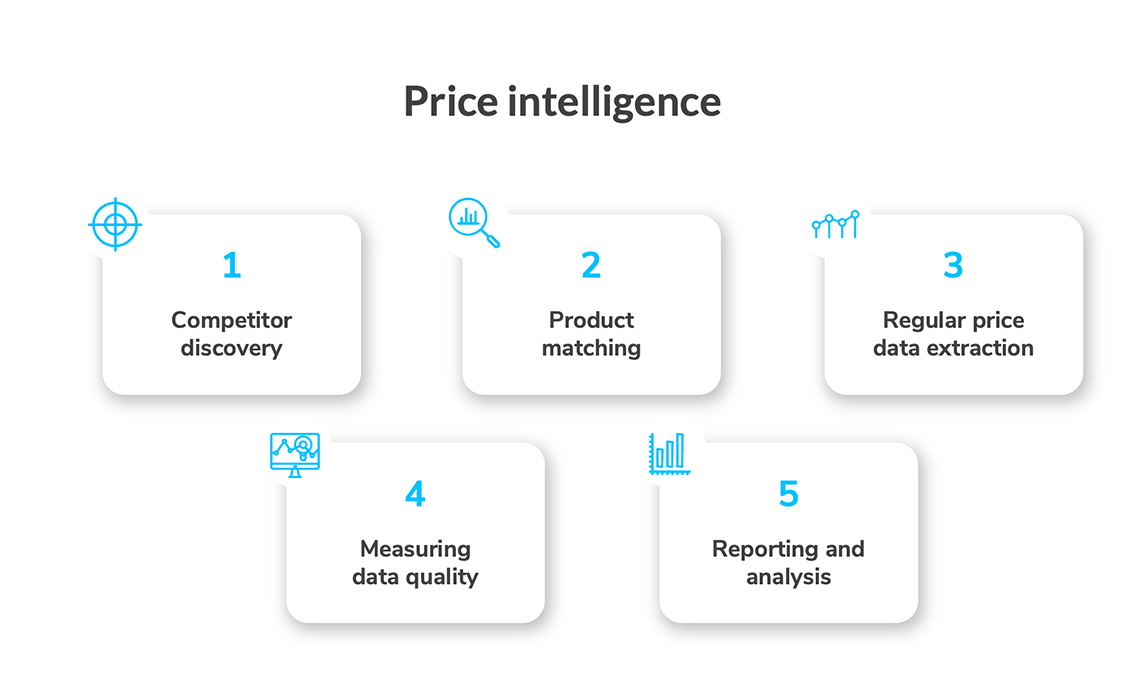Today, winning in omnichannel commerce means leveraging a data-driven approach that combines analytics, automation, and digital tools to optimize marketing and sales activities and increase brand visibility. As the customer experience evolves, companies slowly shift towards a customer-centric approach. This includes understanding the “why” behind buying behaviors by gathering relevant channel insights. Organizations that have embraced customer centricity are 60% more profitable compared to other companies. They often implement strategies like price intelligence to harvest more insights and yield returns.
In recent years, big data has had a major influence on all sectors, resulting in an increased demand for automation and data management tools. However, defining the right strategy to optimize your multichannel sales and provide accurate product content across different touchpoints can be challenging. Not only do you have to identify the channels that can help you get the most out of your data – but also efficiently integrate them to boost your performance.
Do you want to learn how coupling channel insights and price intelligence can deliver valuable input to optimize the performance of your products per channel, or your overall customer experience? And how to develop a successful omnichannel commerce strategy? Let’s dive in.
Data-to-insights becomes insights-to-action
In a recent session from Contentserv Insights webinar series, Benny Kneissl, Head of Data and AI at Contentserv, and Sebastian Klumpp, the CEO of XPLN, provided key recommendations on how to continuously optimize the omnichannel experience. It all starts with centralizing product data — a key differentiator in eCommerce. Providing rich product information to users, with enough data that covers every product detail and complementary materials that compensate for what is missing in a non-physical shopping experience, is crucial to convince them to buy. Then if you sell on different channels, your business must effectively unify its data across all touchpoints. With an effective data integration process, you can connect different applications and automate data delivery to build consistency across a wide range of channels.
The next step is monitoring your prices in comparison with your competitors. This is where you use market insights for your pricing strategies to consistently provide the best offer. Those who monitor the competition across the board and understand market developments in eCommerce can use price intelligence methods to assess product range trends, increase conversions, and raise margins. But the price isn’t the only factor customers value. The fact is 90% of buyers read online customer reviews before visiting a business. That’s why review analysis is critical as it helps understand what customers think of your business. This customer-centric activity enables you to make decisions on what to improve based on what your customers value. So, you can take that information and flow it back into your production process.
Finally, you can increase sales by providing personalized and contextualized experiences. The context of the customer engagement, lifecycle phase, services, and interactions with other channels should form the basis of the overall customer experience. By focusing on contextualization, you can create the right environment for meaningful customer engagements. The process often starts with gathering real-time contextual data, enriching the profiles with new customer insights, creating engaging journeys, assessing customers’ responses, and optimizing the process accordingly so that the right messages reach the right customers.
How do channel insights help in product data syndication?
The smoother the product data syndication process is, the stronger your brand is. For instance, when your digital shelves are automatically updated with the relevant stock quantity for each SKU of a particular item, the fewer delayed or canceled orders a webshop will have. Retailers are constantly updating their product experiences because they want to differentiate themselves from everyone else. So, they update their product requirements and product information constantly. This means companies must quickly publish and syndicate product data across all their customer touchpoints or risk losing sales due to poor experiences.
But this is not possible without accurate channel insights. Collecting the right data and transforming it into actionable insights enables companies to spot risks, find growth opportunities, and make smarter decisions. Put simply, syndication requires a flexible data model to meet the constantly changing commerce requirements. How quickly can you see category-level data about how products, including those of your competitors, are performing on a range of eCommerce sites? With Digital Shelf Analytics (DSA) tools, you can eliminate guesswork by accessing data regarding the status of your products: their positioning and visibility online, customer reviews, the competitiveness of their prices, and the accuracy of their data. With knowledge of user behavior, you can maximize your product data syndication efforts.



 The components of price intelligence: the capacity to monitor, track, and analyze market price data.
The components of price intelligence: the capacity to monitor, track, and analyze market price data.

